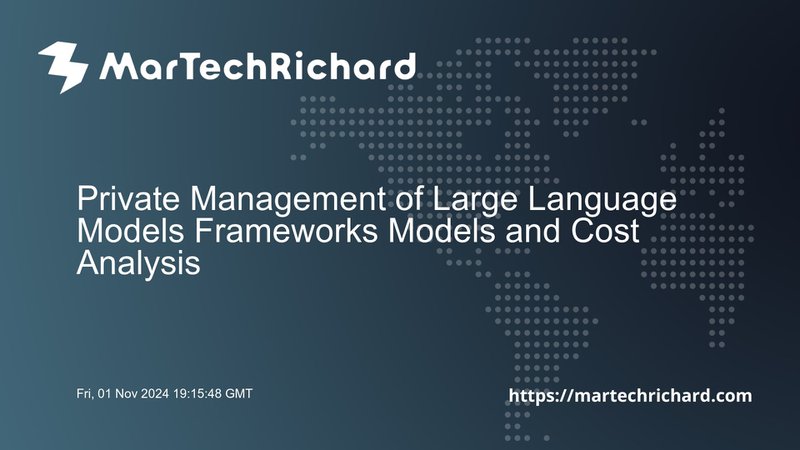
Running Large Language Models Privately: A Comparison of Frameworks, Models, and Costs
In the rapidly evolving landscape of AI, running large language models (LLMs) privately has become a pressing concern for many organizations. The need for privacy and cost-effectiveness is driving the development of various frameworks and models designed to meet these demands. A recent article on Towards Data Science delves into the comparison of different frameworks, models, and costs associated with running LLMs privately. Here’s a summary of the key points and additional insights:
Key Takeaways
The article discusses the challenges and opportunities in running LLMs privately. It compares several frameworks and models, highlighting their strengths and weaknesses in terms of privacy, cost, and performance. The authors evaluate frameworks such as Hugging Face Transformers, OpenAI's GPT-4, and Anthropic's Claude, among others. They also explore the costs associated with each framework, including computational resources and data storage requirements.
One of the primary concerns is the trade-off between privacy and performance. Larger models like GPT-4 offer superior performance but come with higher computational costs and potential privacy risks due to their extensive data requirements. In contrast, smaller models like those from Anthropic's Claude series provide better privacy but may compromise on performance.
Additional Insights
- Privacy Considerations: The article emphasizes the importance of data privacy in the context of LLMs. With the increasing use of LLMs in various applications, ensuring that sensitive data is not leaked or compromised is crucial. This can be achieved through the use of secure frameworks that encrypt data both in transit and at rest.
- Cost Optimization: The cost of running LLMs can be substantial, especially for large-scale applications. The article suggests strategies for cost optimization such as using cloud services with flexible pricing models or leveraging local machine learning capabilities for smaller models.
- Model Selection: The choice of LLM model depends on the specific use case. For instance, if high performance is required but privacy is a concern, models like GPT-4 might be used with additional security measures in place. On the other hand, if privacy is paramount, smaller models like those from Anthropic could be more suitable.
Discussion
When selecting a framework for running large language models (LLMs) privately, organizations must carefully weigh several key factors, including performance, cost, and privacy. The decision to run LLMs in-house versus relying on third-party cloud services is often driven by the need for enhanced data privacy and control. By hosting LLMs on private servers, businesses can ensure that sensitive data remains secure and within their control, avoiding the risks associated with sending information to external providers. However, this approach comes with trade-offs in terms of hardware requirements, power consumption, and the technical complexity of managing these models locally.
To strike a balance between high performance and data privacy, organizations should consider the size of the model they intend to use and the hardware they have available. Smaller models, such as Llama 3.1's 8 billion parameter version, can be run on standard desktop setups with manageable power consumption and cost. Larger models with billions of parameters require more advanced hardware setups, such as GPUs capable of handling extensive computations. Techniques like quantization can help reduce the memory footprint and computational load by approximating model weights without significantly sacrificing accuracy. This allows for faster execution and lower energy consumption, making it possible to run powerful models even on constrained hardware setups.
Looking ahead, future developments in LLM technology are expected to address many of the current challenges around privacy and performance. Innovations in model compression techniques like quantization will likely continue to improve efficiency, allowing organizations to run larger models privately without requiring prohibitively expensive infrastructure. Additionally, advances in federated learning and differential privacy could enable more secure training and inference processes by ensuring that sensitive data never leaves an organization's environment while still benefiting from collective learning across decentralized systems. These developments will be crucial in helping organizations meet the growing demand for both high-performance AI solutions and stringent data privacy protections.
In conclusion, as LLM technology evolves, businesses will need to stay informed about new frameworks and tools that offer the best trade-offs between cost, performance, and privacy. By leveraging private server deployments alongside emerging innovations in AI security and efficiency, organizations can maintain control over their data while still harnessing the transformative power of large language models.
Discuss with us
If you're interested in learning more about how to run large language models privately or have specific questions about the frameworks and models discussed, feel free to contact us via email at [email protected] for further inquiry. You can also reach out to us via LinkedIn message and subscribe to our LinkedIn page and newsletters via LinkedIn Page.
Source URL
Source Article: https://towardsdatascience.com/running-large-language-models-privately-a-comparison-of-frameworks-models-and-costs-ac33cfe3a462
